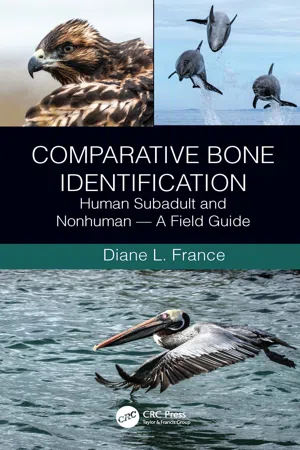
Comparative Bone Identification
Human Subadult and Nonhuman - A Field Guide
Diane L. France
- 592 páginas
- English
- ePUB (apto para móviles)
- Disponible en iOS y Android
Comparative Bone Identification
Human Subadult and Nonhuman - A Field Guide
Diane L. France
Información del libro
Building on the success, and maintaining the format, of Comparative Bone Identification: Human Subadult and Non-Human (ISBN: 9780367777883), Comparative Bone Identification: Human Subadult and Non-Human – A Field Guide presents new images of human bones representing many states of maturation from neonate to 20 years old in comparison to a variety of animal species' bones.
Highly illustrated, the book takes a visual approach and provides full annotations pointing out salient features of the most commonly discovered bones. This includes smaller bones of fetuses and subadult humans in comparison to bones of birds, reptiles, marine mammals, fish, and a frog that human bones may most be confused with. Full-color photos provide clear examples for use by law enforcement, medicolegal death investigators, forensic anthropologists, students, and readers who wish to distinguish between human bones and those of a variety of animal species.
The book is not intended to be an exhaustive guide to human and nonhuman skeletons. It offers myriad photos and illustrations to help aid in identification and avoid some of the more commonly confused animal bones for human. The book begins with an introduction section on general osteology and explains the major anatomical differences between humans and other animals. The second section compares human and nonhuman bones, categorized by type of bone, and includes most of the major bones in humans and nonhumans. The third section presents of radiographs illustrated documented age in humans.
Conveniently designed for field use, Comparative Bone Identification: Human Subadult to Nonhuman – A Field Guide offers users a practical comparative guide that presents the differences among species for nearly all bones in the body. The book serves as a valuable resource of easy-to-access information to investigators and forensic anthropologists for use in the laboratory or in the field.
Preguntas frecuentes
Información
I Introduction








ANATOMICAL TERMINOLOGY
- Anatomical Position: body with arms by side, palms forward
- Anterior: in front (similar to ventral)
- Appendicular: the skeleton of the limbs
- Axial: the skeleton of the head and trunk
- Caudal: toward the tail
- Coronal plane: parallel to the coronal suture
- Cranial: toward the head
- Distal: away from trunk of body along a limb
- Dorsal: in back (similar to posterior)
- External: outside of
- Inferior: lower
- Internal: inside of
- Lateral: perpendicularly away from midsagittal plane
- Longitudinal: coursing or placed lengthwise
- Medial: perpendicularly toward the midsagittal plane
- Posterior: behind, to the back (similar to dorsal)
- Pronation: rotation of the hand and forearm so that the palm faces dorsally or toward the body
- Proximal: toward the trunk of the body along a limb
- Sagittal Section: any section of the body parallel to the sagittal suture of the cranium
- Superficial: near the surface
- Superior: above, top
- Supination: turning the palm of the hand anteriorly
- Transverse: any crosswise section
- Ventral: in front (similar to anterior)
- Vertex: top, highest point
- In mouth:
- Buccal: toward the cheek
- Distal: at greatest distance from the anterior midline of the mouth
- Labial: toward the lips
- Lingual: toward the tongue
- Mesial: toward the anterior midline of the mouth
- Occlusal: the chewing surface of the teeth
FEATURES OF BONE
| Feature (plural): | Definition: |
|---|---|
| Cavity (cavities): | an open area |
| Condyle (condyles): | rounded process at the point of articulation with another bone |
| Crest (crests): | a projecting ridge |
| Diaphysis (diaphyses): | the shaft of bone |
| Epiphysis (epiphyses): | a process of bone initially attached to another piece of bone by cartilage, and usually later consolidated with it by bone |
| Fontanelle (fontanelles): | membranous space between cranial bones in fetal life and infancy |
| Foramen (foramina): | a hole or opening |
| Fossa (fossae): | a pit, depression, or cavity |
| Meatus (meatuses): | a canal |
| Process (processes): | any outgrowth or prominence of bone |
| Sinus (sinuses): | bone cavity lined with mucus membrane |
| Suture (sutures): | areas of articulation between cranial bones |
| Torus (tori): | an elevation or prominence |
| Tubercle (tubercles): | a small, knob-like projection on bone |
| Tuberosity (tuberosities) | a large, rough eminence or projection on bone |